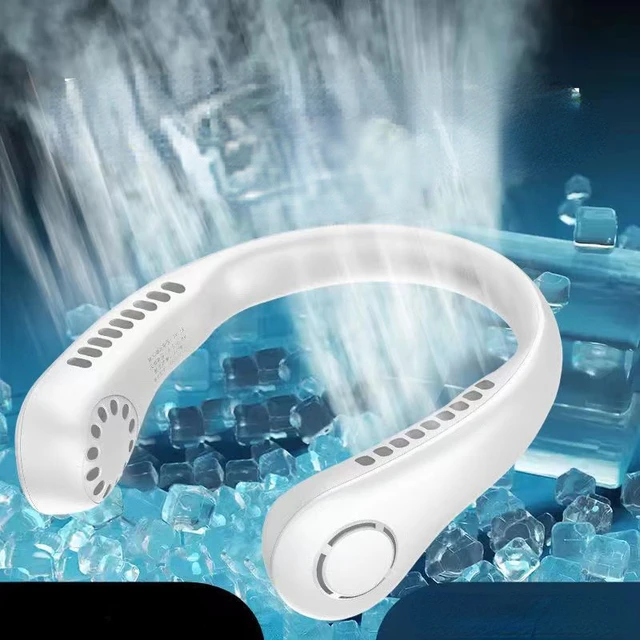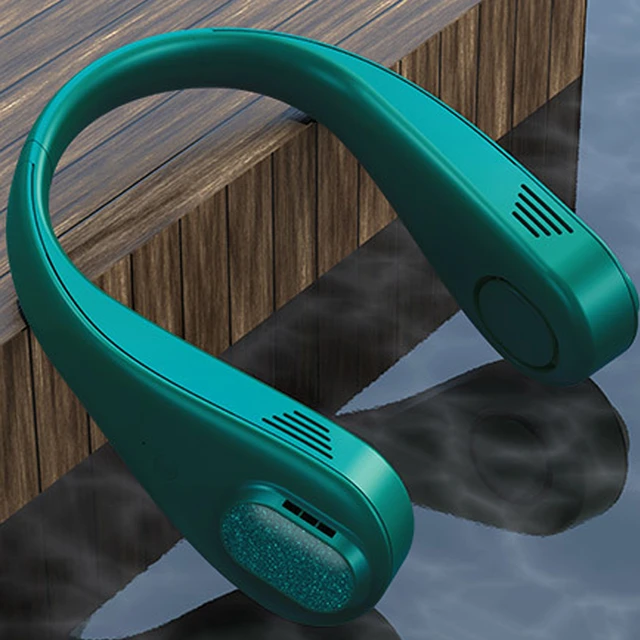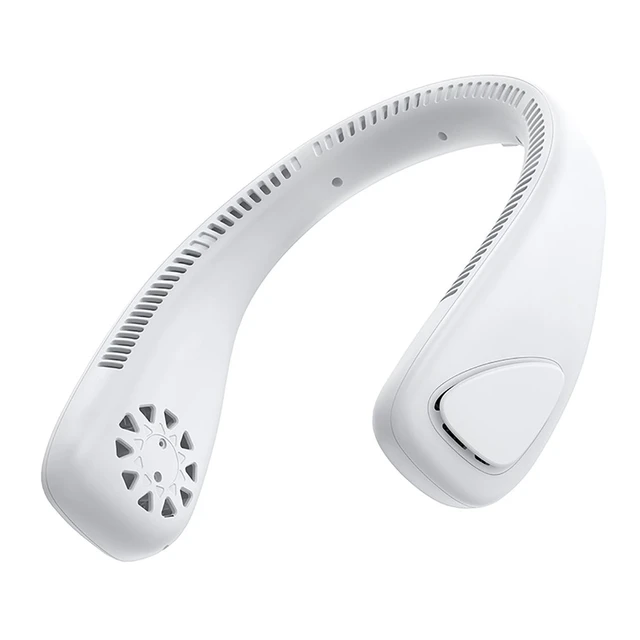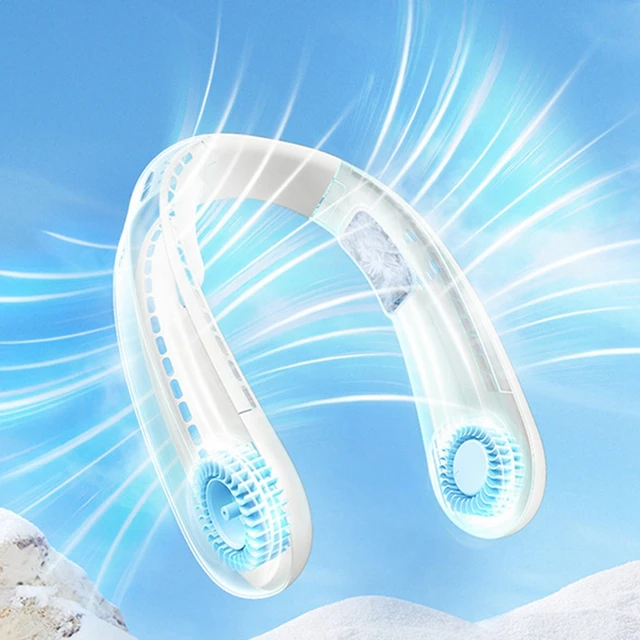Introduction
The battery life of neck fans is an important consideration for users, as it determines the duration of cooling relief before the device needs to be recharged. In this guide, we will provide a detailed analysis of the typical battery life of neck fans, exploring factors that affect battery consumption, tips for maximizing battery life, and considerations when choosing a neck fan based on battery performance.

How long does the battery of a neck fan typically last?
Factors Affecting Battery Life
1.1. Fan Speed Setting
The speed setting at which the neck fan operates significantly impacts its battery life. Higher fan speeds consume more power, resulting in shorter battery life. Conversely, lower fan speeds are more energy-efficient and can extend the battery life of the neck fan. Users should consider their cooling needs and adjust the fan speed accordingly to optimize battery usage.
1.2. Battery Capacity
The capacity of the neck fan’s battery is a crucial factor in determining its battery life. Higher capacity batteries can store more energy and provide longer usage before requiring a recharge. The battery capacity of neck fans typically ranges from 800mAh to 2000mAh, with higher capacity batteries providing longer battery life. This may be different from some small appliances like electric heating pads.
1.3. Usage Patterns
The duration and frequency of use also affect the battery life of neck fans. Continuous usage at higher fan speeds drains the battery faster than intermittent or lower speed usage. Users who frequently use their neck fans at higher speeds may experience shorter battery life compared to those who use them sparingly or at lower speeds.
1.4. Charging Cycles
The number of charging cycles a neck fan battery undergoes can impact its overall battery life. Over time, repeated charging and discharging can gradually reduce the battery’s capacity, resulting in shorter battery life. While modern lithium-ion batteries used in neck fans are designed to have a long lifespan, users should be aware that battery performance may decline slightly over time. This may be different from some small appliances like an electric toothbrush.

Typical Battery Life of Neck Fans
2.1. Low-Speed Setting
On the lowest fan speed setting, neck fans with a battery capacity of around 1500mAh typically provide a battery life of approximately 6 to 8 hours. This duration may vary depending on the specific model and usage conditions. Neck fans with higher battery capacities can offer even longer battery life at low speeds, ranging from 8 to 12 hours or more.
2.2. Medium-Speed Setting
At medium fan speed settings, the battery life of neck fans is generally shorter compared to low-speed usage. Neck fans with a battery capacity of around 1500mAh can last for approximately 4 to 6 hours at medium speeds. Higher capacity batteries may provide battery life between 6 to 8 hours or more at medium speeds.
2.3. High-Speed Setting
When operated at the highest fan speed setting, neck fans consume more power and have a shorter battery life. On average, neck fans with a battery capacity of around 1500mAh last approximately 2 to 4 hours at high speeds. Neck fans with higher capacity batteries may still provide a battery life of 4 to 6 hours or more at high speeds.
Maximizing Battery Life
3.1. Adjust Fan Speed According to Needs
To maximize the battery life of a neck fan, users should adjust the fan speed according to their cooling requirements. Lower fan speeds are more energy-efficient and extend the battery life. By using the neck fan at the lowest speed that provides sufficient cooling, users can optimize battery usage and prolong the time between recharges.
3.2. Utilize Intermittent Usage
Users can also maximize the battery life by utilizing intermittent usage patterns. Rather than using the neck fan continuously for extended periods, taking breaks between usage can help conserve battery power. This approach allows the neck fan to rest and the battery to recharge during breaks, ensuring longer overall battery life.
3.3. Optimize Charging Practices
Proper charging practices can also contribute to maximizing the overall battery life of neck fans. Users should follow the manufacturer’s instructions regarding charging times and avoid overcharging the battery. It is recommended to disconnect the neck fan from the power source once the battery is fully charged to prevent unnecessary strain on the battery.

Choosing a Neck Fan Based on Battery Performance
4.1. Consider Battery Capacity
When selecting a neck fan, consider the battery capacity as it directly impacts the battery life. Higher capacity batteries, typically ranging from 1500mAh to 2000mAh, offer longer usage times before requiring recharging. Users with a need for extended cooling periods, such as outdoor activities or all-day use, may prefer neck fans with higher capacity batteries.
4.2. Evaluate Charging Time
In addition to battery life, it is important to consider the charging time of neck fans. Some neck fans may take longer to fully charge compared to others. Neck fans with fast charging capabilities or quick recharge times can be beneficial for users who need their device to be ready for use in a shorter amount of time.
4.3. User Reviews and Recommendations
User reviews and recommendations can provide valuable insights into the actual battery performance of specific neck fan models. Reading reviews from other users who have tested the battery life under real-world conditions can help assess the accuracy of manufacturers’ claims. Users can also seek recommendations from friends or trusted sources who have experience with specific neck fan models.

Battery Life Tips for Extended Use
6.1. Carry a Power Bank
For users who anticipate longer periods of use or limited access to charging outlets, carrying a portable power bank can be a practical solution. Power banks can provide additional charging capacity on the go, allowing users to recharge their neck fans whenever needed. It is important to choose a power bank with sufficient capacity to fully charge the neck fan’s battery multiple times.
6.2. Opt for Low-Speed Usage
To extend the battery life during extended use, it is advisable to use the neck fan at the lowest speed setting that offers adequate cooling. Lower fan speeds consume less power, resulting in longer battery life. By utilizing the lower speed settings, users can enjoy cooling relief for a longer duration before needing to recharge the neck fan.
6.3. Take Breaks
During extended use, taking intermittent breaks from using the neck fan can help conserve battery power. By turning off the neck fan during short intervals, such as during rest or when moving to a cooler environment, users can maximize the overall battery life. This approach allows the neck fan to rest and the battery to recharge, ensuring longer cooling periods throughout the day.
6.4. Optimize Charging Time
To minimize downtime and ensure the neck fan is always ready for use, users should aim to optimize charging times. Charging the neck fan during periods when it is not in use, such as overnight or during breaks, can help maximize the availability of a fully charged battery. By strategically planning charging times, users can minimize interruptions in cooling relief. This is similar to how electric heaters save energy.

Conclusion
The battery life of neck fans varies depending on factors such as fan speed setting, battery capacity, usage patterns, and charging cycles. Typically, neck fans with a battery capacity of around 1500mAh provide 6 to 8 hours of usage at low speeds, 4 to 6 hours at medium speeds, and 2 to 4 hours at high speeds.
To optimize the battery life of neck fans, users should adjust the fan speed according to their cooling needs, utilize intermittent usage patterns, and follow proper charging practices. It is also important to consider the battery capacity and charging time when selecting a neck fan based on individual cooling requirements.
By understanding the factors that affect battery life and employing strategies to maximize usage, users can make informed decisions and select a neck fan that provides sufficient cooling relief while meeting their desired battery performance expectations.

